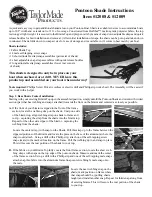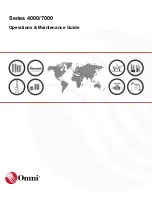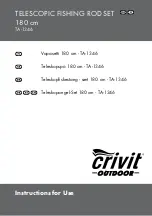
www.good-lite.com | 1.800.362.3860 | 1.888.362.2576 fax
2
HOTV Near Vision Card
Part Number: 731000
To determine the visual acuity use one of the
following formulas:
Note that it is incorrect to report "V.A. 20/25 at 8 inches" if the
child could read the 20/25-line (.50M line) at 8 inches. Visual acuity
is in that case: 8"/16" x 20/25 = 1/2 x 20/25 = 20/50. (When using
the British notation: 6/9 line at 20cm equals: 20cm/40cm x 6/9 =
1/2 x 6/9 = 6/18. When using the decimal notation 0.8 line at 20cm
equals: 20cm/40cm x 0.8 = 1/2 x 0.8 = 0.4.)
When the distance is one half (or one third) of the standard
distance, the visual acuity value is also one half (one third) of the
value printed next to that line.
If you do not want to do the calculations, report the result as
M-unit value, i.e. in the previous case .50M at 8” (20cm). Visual
acuity is easy to calculate based on these values: VA = 0.2m/.50M
= 2/5=4/10=0.4 or 2/5=20/50 or 2/5=6/15 the closest being
6/18.
The calculation is based on metric measurements. The
corresponding visual acuity values in the American and in the
British notation you can also find on the visual acuity chart. If the
exactly corresponding value is not printed on the chart, calculate
it as follows: For example 0.07= 7/100= [7x3/100x3]=21/300 or
20/300; or for the British notation: 0.07=7/100=6/86 (6x100/7=86)
You multiply both the numerator and the denominator with the
number that makes the numerator equal or closely equal to 20
or 6.
Test Procedure for Mass Preschool Protocal:
50% Crowding Box
1. Point to the child’s left eye and tell the child to close that
eye. Place a patch or other cover over the child’s left eye.
Alternatively, the child or an assistant may use the palm of
his/her hand to completely cover the eye. It is very important
to observe the child carefully to ensure that he/she does
not peek around the hand. Covering the eye with fingers is
not allowed because peeking is too easy with only fingers in
front of the eye. Children with poor vision in one eye are the
ones most likely to peek! If the child persists in peeking, the
child should be referred for a comprehensive eye exam by an
ophthalmologist or optometrist.
2. Move to the wall chart or the location (10 feet from the child)
where the MassVAT flip cards will be presented.
3. If using the MassVAT flip cards, go to the two cards which
correspond to the child’s age. Point to the first letter/symbol
on the R card (for the right eye). Be very careful to point just
below the rectangular box around the letters/symbols. The
pointer (finger or pencil) must not cover the letter/symbol or
extend over the line of the rectangular box, i.e. don’t “break
the box”. Masking, i.e. presenting one letter/symbol at a
time, can overestimate the visual acuity in children with poor
vision. Ask the child to name the letter/symbol or point to the
matching letter/symbol on the lap card. If the child is correct,
point to the second letter/symbol and have the child name or
match it. Continue pointing to the letters/symbols, one at a
time, until the child correctly names at least 4 of the 5 letters/
symbols on the line. If the child misses 2 letters/symbols,
stop there, record the results on the data sheet, and proceed
to testing of the left eye. The child must correctly name or
match 4 of the 5 letters/symbols on the line to pass the test
for that eye. If the child is unable to correctly name or match
at least 4 letters/symbols on a line for each eye, the child
needs to be referred for a comprehensive eye examination
by an ophthalmologist or optometrist. If using a wall chart,
point to one letter/symbol at a time on the line appropriate for
the child’s age. As noted above, be careful not to cover the
surrounding letters or symbols with your finger or pencil
when pointing.
4. After testing of the right eye has been completed, cover the
right eye, and proceed with testing of the left eye. Repeat the
testing procedure by starting with the L card (for the left eye)
if using the MassVAT flip cards. If using the wall chart, point
to the letters or symbols on the appropriate line in a different
order from that used when the right eye was tested, in order
to help prevent memorization.
5. The acuity level required for a child under 4 years of age
to pass is 10/20 (equivalent to 20/40). The acuity level
required for children 4 years of age and older to pass is 10/16
(equivalent to 20/32, with MassVAT) or 10/15 (equivalent to
20/30, with the wall chart)
What You Tell the Child:
1. Keep encouraging the child to respond to your questions.
Urge the child to keep naming or matching the letters/symbols
even if the child must guess.
2. Provide positive comments about the child’s performance,
regardless of whether the child identifies the letter/symbol
correctly or incorrectly.
3. Remind the child to stay seated and look straight ahead at the
flip cards or the wall chart.
4. Repeat the command to keep the eye covered.
What You Write Down:
1. Circle “Pass” or “Refer”.




















